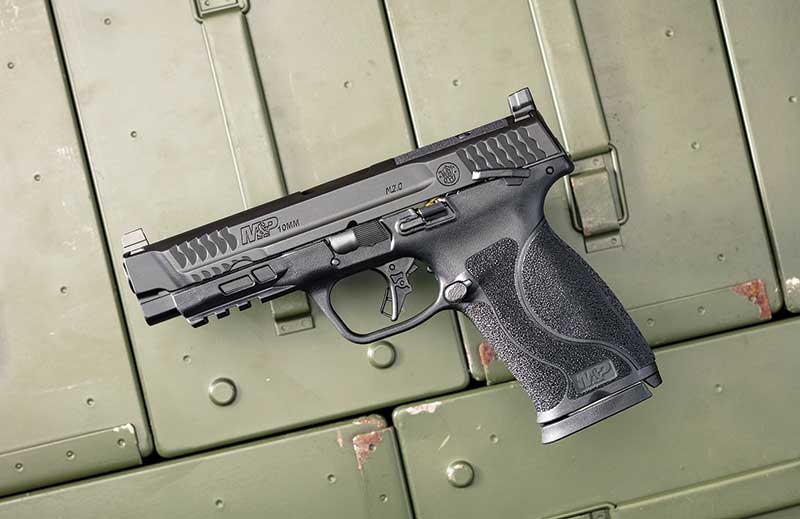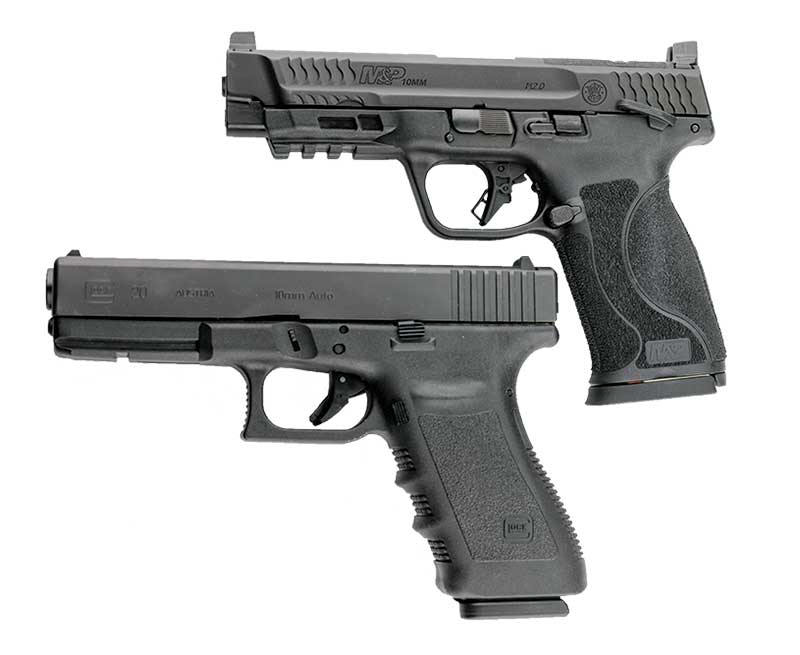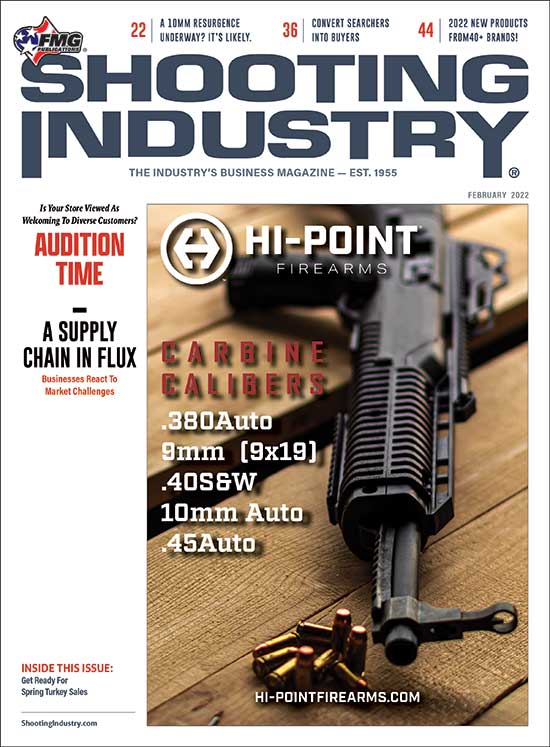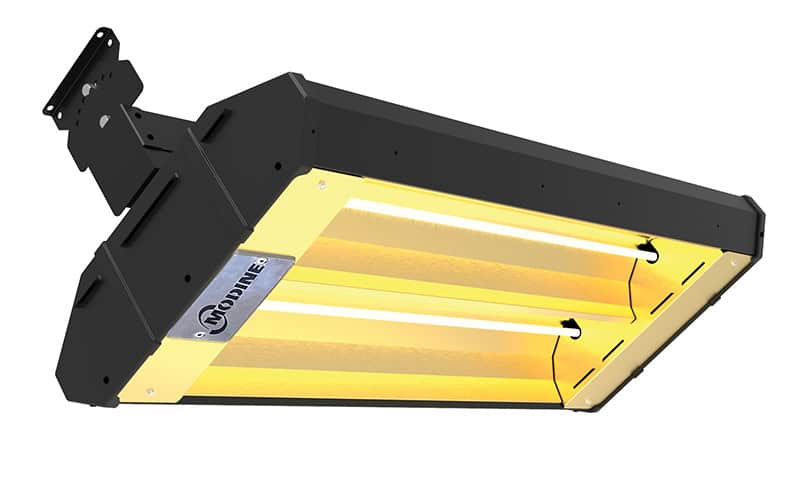A 10mm Resurgence?
When the 10mm pistol cartridge was introduced in the early ’80s, one of its godfathers was Col. Jeff Cooper, who predicted it would replace his beloved .45 Auto in the hands and holsters of serious combat handgun cognoscenti. When the FBI adopted it a few years later, it was postulated it would soon become the new standard in law enforcement.
Neither of those things worked out … but consumer interest in the 10mm today is growing nonetheless. Gun companies don’t introduce new products their marketing researchers don’t think will sell. Let’s look at some recent introductions.
New Options
Springfield Armory: The only firm offering 10mm chambering in two different formats, Springfield Armory in the last few years has covered both the 1911 and the striker-fired waterfronts. Retailing for well under $1,000 is the Ronin, an all-steel 1911 10mm that has tested well.
The XD(M) 5.25 pistol is polymer-framed and striker-fired, and like all such pistols costs less for the manufacturer to produce and therefore offer at a more affordable price tag to your customers. One feature I particularly like on the XD(M) is its adjustable sights. These allow your more finicky customers to dial in for exact point of aim/point of impact with any of the wide variety of 10mm ammo in the catalogs.
Smith & Wesson: Their all-steel Gen 3 pistol, the traditional double-action Model 1076, was the gun the FBI adopted in the late 1980s and discontinued earlier than anyone expected. In late 2021, S&W jumped back into the 10mm game with the large (.45-size) version of their striker-fired M&P. Bolstered with a rugged steel chassis within its polymer frame, I found it to be accurate and controllable in testing.
GLOCK: The 10mm G20 pistol, introduced in 1990, remains the bestselling 10mm pistol in most gun shops. It set the format of 15+1 cartridge capacity which was followed by both the XD(M) and the M&P. The smaller version of the G20, the G29, has been a steady seller if not a bestseller for three decades now, and remains the only compact polymer 10mm on the market. A few years ago GLOCK supplemented the G20 with the long-slide (5.3″ barrel) G40, and an MOS version already cut for red dot sights. All remain in the catalog, which tells us the 10mm is here to stay for a while.
Not Just Semi-Autos
And, let’s not forget revolvers. Ruger chambers its GP-100 in 10mm, and S&W has reintroduced its N-Frame Model 610 in the same caliber. With the furnished moon clips, they offer the fastest possible revolver reload for your customers who prefer round guns to square ones, and those moons allow .40 S&W to be fired from these 10mms as well. (That much more versatility, yes? Speaking of which, a sales tip: For your customers with GLOCK 20 pistols, Lone Wolf offers its Alpha Wolf barrel chambered for .40 S&W.)
The “Why” Of The 10mm
In Alaska, outdoor sports are particularly popular — not just hunting, but fishing and hiking. They have big bears there, and a whole lot of people find it easier to carry a powerful handgun than a high-powered rifle or a slug-loaded shotgun. .357 Magnums and .44 Magnums were long the preferred choice, but the deep penetration of solid 10mm bullets gives the user a lot more chances to get a killing shot into a charging bear because they hold so many more rounds and an opportunity to reload is most unlikely during a large animal attack.
”10mm bullets [give] the user a lot more chances to get a killing shot into a charging bear because they hold so many more rounds and an opportunity to reload is most unlikely during a large animal attack.“
Most revolvers are six-shooters. Polymer 10mm Auto pistols are 16 shooters. Bears are more likely to be warded off by warning shots than humans, it seems, and the warning shot has become almost customary in these human/ursine situations. Let’s assume your customer is a Smith & Wesson fan. Each warning shot consumes 16.6% of his or her in-gun ammo capacity — that is, 16.6% of their last-chance bear attack survival potential — if they’re carrying a typical Magnum revolver. But if you’ve turned the page of the S&W catalog and sold them a 10mm Military & Police pistol with 16-round total capacity, the price of the warning shots is reduced to 6.25% per. That’s a much easier price to pay in the balance of bear conservation vis-à-vis human survival.
In most parts of the country, great big bears are not a problem. However, every state has farms and ranches. So — particularly if your shop is in a rural area — let’s talk. Not just you and me, but you and your clientele.
Research shows: Every year, several times more people are killed by domestic livestock than are killed by bears. It might be a bad-tempered bull, a rogue horse or even an enraged hog. What do those animals have in common with bears? Well, they’re big, they’re heavy and two out of three are more likely to stomp you to death than bite or claw you to death. They are all quadrupeds that will come at you on all fours, presenting you with a long, deep body that will require deep penetration to reach vital organs. They also have thick, heavy skulls, which will present on a sloping angle as they come at you: a perfect combination for deflecting all but the most penetrative bullets if you hope for a brain shot that will immediately shut down the attack.
Sounds like a good argument for the 10mm on farm or ranch to me.
If we read the work of the legendary Elmer Keith, we see more than once a powerful handgun saved him from a large animal thanks to its deep-penetrating bullets. Keith’s name may not register with your Millennial customers, but it will certainly strike a responsive chord with your older clientele who have read a lot and are familiar with the lore of the gun.
Versatility Sells
A broad variety of 10mm Auto ammo is available. The original load was a 200-grain jacketed truncated cone bullet at about 1,200 fps. In the early days of the 10mm, the late, great Larry Kelly installed a 6″ Mag-na-ported Bar-Sto barrel on my 10mm Colt Delta Elite. Before he sent it back to me, he killed a humongous hog with it. He told me the animal’s live weight was about 600 pounds, and that a factory Norma FMJ bullet entered the brisket from straight-on front, passed through the entire animal lengthways and exited its butt. It quickly fell. Larry told me he donated the carcass to the roasting spit at the Second Chance Shoot in Michigan that year.
Personal defense? If recoil is an issue, there is the “FBI load,” a 180-grain jacketed hollowpoint in the 1,000 fps velocity range. These are essentially .40 S&W ballistics, long since proven “adequate as a man-stopper,” and offer mild recoil when fired from a large-frame 10mm pistol.
Full-power 10mm ballistics for when a homicidal biped must be quickly neutralized? I am partial to a 165-grain bullet in the 1,300 fps range. When the 10mm had some traction in law enforcement, the Winchester Silvertip 10mm (recently reintroduced!) offered a 175-grain JHP at 1,290 fps, generating 649 foot-pounds of muzzle energy. This almost exactly equaled Winchester’s Silvertip load for a .41 Magnum revolver.
For the big stuff? If the customer really does need to ruin a bruin, Buffalo Bore offers a Dangerous Game load comprised of a 190-grain flat-nose Mono-Metal bullet from Lehigh. Such a load promises bone-crushing deep penetration.
The bottom line? The currently resurgent 10mm Auto is still a niche product, but the niche is growing. It is hoped the above points will help you sell more, and create more satisfied customers.







